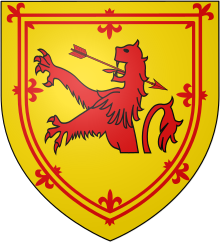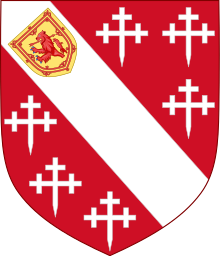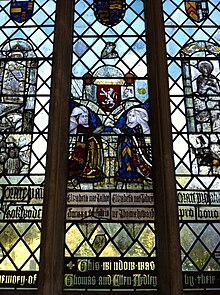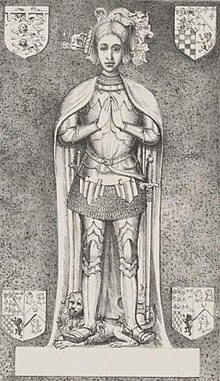| This article includes a list of references, related reading, or external links, but its sources remain unclear because it lacks inline citations. Please help improve this article by introducing more precise citations. (December 2022) (Learn how and when to remove this message) |
Not to be confused with Thomas Howard, 3rd Duke of Norfolk.
| His GraceThe Duke of NorfolkKG PC | |
|---|---|
 1907 copy of a contemporary depiction 1907 copy of a contemporary depiction | |
| Lord High Treasurer | |
| In office 16 June 1501 – 4 December 1522 | |
| Monarchs | Henry VII Henry VIII |
| Preceded by | John Dynham, 1st Baron Dynham |
| Succeeded by | Thomas Howard, 3rd Duke of Norfolk |
| Earl Marshal | |
| In office 1509–1524 | |
| Preceded by | The Duke of York |
| Succeeded by | The Duke of Suffolk |
| Member of the House of Lords Lord Temporal | |
| In office 1514 – 21 May 1524 Hereditary Peerage | |
| Preceded by | The 1st Duke of Norfolk |
| Succeeded by | The 3rd Duke of Norfolk |
| Personal details | |
| Born | 1443 Stoke-by-Nayland, Suffolk |
| Died | 21 May 1524(1524-05-21) (aged 80–81) Framlingham Castle, Suffolk |
| Spouses |
|
| Children | Thomas Howard, 3rd Duke of Norfolk Sir Edward Howard Lord Edmund Howard Elizabeth Boleyn, Countess of Wiltshire William Howard, 1st Baron Howard of Effingham Lord Thomas Howard Dorothy Stanley, Countess of Derby 11 more |
| Parents |
|
Thomas Howard, 2nd Duke of Norfolk KG PC (1443 – 21 May 1524), styled Earl of Surrey from 1483 to 1485 and again from 1489 to 1514, was an English nobleman, soldier and statesman who served four monarchs. He was the eldest son of John Howard, 1st Duke of Norfolk, by his first wife, Catharina de Moleyns. The Duke was the grandfather of both Queen Anne Boleyn and Queen Katherine Howard and the great-grandfather of Queen Elizabeth I. In 1513, he led the English to victory over the Scots at the decisive Battle of Flodden, for which he was richly rewarded by King Henry VIII, then away in France.
Early life
Thomas Howard was born in 1443 at Stoke-by-Nayland, Suffolk, the only surviving son of John Howard, later 1st Duke of Norfolk, by his first wife, Katherine, the daughter of Sir William Moleyns (died 8 June 1425) and his wife Margery. He was educated at Thetford Grammar School.
Service under Edward IV
While a young man, he entered the service of King Edward IV as a henchman. Howard took the King's side when war broke out in 1469 with the Earl of Warwick, and took sanctuary at Colchester when the King fled to Holland in 1470. Howard rejoined the royal forces at Edward's return to England in 1471, and was severely wounded at the Battle of Barnet on 14 April 1471. He was appointed an esquire of the body in 1473. On 14 January 1478 he was knighted by Edward IV at the marriage of the King's second son, the young Duke of York, and Lady Anne Mowbray (died 1481).
Service under Richard III

After the death of Edward IV on 9 April 1483, Thomas Howard and his father John supported Richard III. Thomas bore the Sword of State at Richard's coronation and served as steward at the coronation banquet. Both Thomas and his father were granted lands by the new King, and Thomas was also granted an annuity of £1000. On 28 June 1483, John Howard was created Duke of Norfolk, while Thomas was created Earl of Surrey. Surrey was also sworn of the Privy Council and invested with the Order of the Garter. In the autumn of that year Norfolk and Surrey suppressed a rebellion against the King by the Duke of Buckingham. Both Howards remained close to King Richard throughout his two-year reign, and fought for him at the Battle of Bosworth in 1485, where Surrey was wounded and taken prisoner, and his father killed. Surrey was attainted in the first Parliament of the new King, Henry VII, stripped of his lands, and committed to the Tower of London, where he spent the next three years.
Service under Henry VII
Howard was offered an opportunity to escape during the rebellion of the Earl of Lincoln in 1487, but refused, perhaps thereby convincing Henry VII of his loyalty. In May 1489 Henry restored him to the earldom of Surrey, although most of his lands were withheld, and sent him to quell a rebellion in Yorkshire. Surrey remained in the north as the King's lieutenant until 1499. He and his family lived in Sheriff Hutton Castle while in the North. In 1496/7 he was given a command against invading Scots and took his sons Thomas and Edward with him. Surrey knighted both of them on 30 September 1497 at Ayton Castle-the very same day the treaty of Ayton was signed.
In 1499 he was recalled to court, and accompanied the King on a state visit to France in the following year. In 1501 he was again appointed a member of the Privy Council, and on 16 June of that year was made Lord High Treasurer. Surrey, Richard Foxe (Bishop of Winchester and Lord Privy Seal) and William Warham (Archbishop of Canterbury and Lord Chancellor), became the King's "executive triumvirate". He was entrusted with a number of diplomatic missions. In 1501 he was involved in the negotiations for Katherine of Aragon's marriage to Arthur, Prince of Wales, and in 1503 conducted Margaret Tudor to Scotland for her wedding to King James IV.
Service under Henry VIII


Surrey was an executor of the will of King Henry VII when the King died on 21 April 1509, and played a prominent role in the coronation of King Henry VIII, in which he served as Earl Marshal. He challenged Thomas Wolsey in an effort to become the new King's first minister, but eventually accepted Wolsey's supremacy. Surrey expected to lead the 1513 expedition to France, but was left behind when the King departed for Calais on 30 June 1513. Shortly thereafter King James IV of Scotland launched an invasion into England, and Surrey, with the aid of other noblemen and his sons Thomas and Edmund, crushed James's much larger force at the Battle of Flodden, near Branxton, Northumberland, on 9 September 1513. The Scots may have lost as many as 10,000 men, and King James was killed. The victory at Flodden brought Surrey great popular renown and royal rewards. On 1 February 1514, at the age of 71, he was created 2nd Duke of Norfolk, his late father's title, and his son Thomas was made Earl of Surrey. Both were granted lands and annuities, and the Howard arms were augmented in honour of Flodden with an inescutcheon bearing the lion of Scotland pierced through the mouth with an arrow.
Final years
In the final decade of his life, Norfolk continued his career as a courtier, diplomat and soldier. In 1514 he joined Wolsey and Foxe in negotiating the marriage of Mary Tudor to King Louis XII of France, and escorted her to France for the wedding. On 1 May 1517, he led a private army of 1,300 retainers into London to suppress the Evil May Day riots. In May 1521 he presided as Lord High Steward over the trial of Edward Stafford, 3rd Duke of Buckingham, father of Norfolk's daughter-in-law, Elizabeth. According to David M. Head, "he pronounced the sentence of death with tears streaming down his face".
By the spring of 1522, Norfolk was almost 80 years of age and in failing health. He withdrew from court, resigned as Lord Treasurer in favour of his son in December of that year, and after attending the opening of Parliament in April 1523, retired to his ducal castle at Framlingham in Suffolk where he died on 21 May 1524. His funeral and burial on 22 June at Thetford Priory were said to have been "spectacular and enormously expensive, costing over £1300 and including a procession of 400 hooded men bearing torches and an elaborate bier surmounted with 100 wax effigies and 700 candles", befitting the richest and most powerful peer in England. After the dissolution of Thetford Priory, the Howard tombs were moved to the Church of St Michael the Archangel, Framlingham. A now-lost monumental brass depicting the 2nd Duke was formerly in the Church of St. Mary at Lambeth.
Marriages and issue

On 30 April 1472, Howard married Elizabeth Tilney, the daughter of Sir Frederick Tilney of Ashwellthorpe, Norfolk, and widow of Sir Humphrey Bourchier, slain at Barnet, son and heir apparent of Sir John Bourchier, 1st Baron Berners. They had issue:
- Thomas Howard, 3rd Duke of Norfolk
- Sir Edward Howard
- Lord Edmund Howard, father of Henry VIII's fifth Queen, Katherine Howard
- Sir John Howard 1482-1530
- Henry Howard
- Charles Howard
- Henry Howard (the younger)
- Richard Howard
- Elizabeth Howard, married Thomas Boleyn, 1st Earl of Wiltshire, and was mother of Queen Anne Boleyn, and grandmother of Queen Elizabeth.
- Muriel Howard (died 1512), married firstly John Grey, 2nd Viscount Lisle (died 1504), and secondly Sir Thomas Knyvet
Norfolk's first wife died on 4 April 1497, and on 8 November 1497 he married, by dispensation dated 17 August 1497, her cousin, Agnes Tilney, the daughter of Hugh Tilney of Skirbeck and Boston, Lincolnshire and Eleanor, a daughter of Walter Tailboys. They had issue:
- William Howard, 1st Baron Howard of Effingham
- Lord Thomas Howard (1511–1537)
- Richard Howard (died 1517)
- Dorothy Howard, married Edward Stanley, 3rd Earl of Derby
- Anne Howard, married John de Vere, 14th Earl of Oxford
- Katherine Howard, married firstly, Rhys ap Gruffydd. Married secondly, Henry Daubeney, 1st Earl of Bridgewater.
- Elizabeth Howard (died 1536), married Henry Radclyffe, 2nd Earl of Sussex.
Note: Thomas Howard indeed had two living daughters named Elizabeth Howard and two living sons named Thomas Howard. It is unclear if he had two sons named Richard as well or if it was the same person. In the Dukes of Norfolk family tree, there is clearly a mistake. Richard Howard is there linked to Agnes Tilney (2nd wife of Thomas Howard), yet is said to born in 1487, which is impossible to be true, as at the time Thomas Howard was married to Elizabeth Tilney.

Family
Ancestors
| Ancestors of Thomas Howard, 2nd Duke of Norfolk | |||||||||||||||||||||||||||||||||||||||||||||||||||||||||||||||||||||||||||||||||||||||||||||||||||||||||||||||||||||||||||||||||||||||||||||||||||||||||||||||||||||||||||||||||||||||||||||||||||||||||||||||||||||||||||||||||||||||||||||||||||||||||||||||||||||||||||||||||||||||||
|---|---|---|---|---|---|---|---|---|---|---|---|---|---|---|---|---|---|---|---|---|---|---|---|---|---|---|---|---|---|---|---|---|---|---|---|---|---|---|---|---|---|---|---|---|---|---|---|---|---|---|---|---|---|---|---|---|---|---|---|---|---|---|---|---|---|---|---|---|---|---|---|---|---|---|---|---|---|---|---|---|---|---|---|---|---|---|---|---|---|---|---|---|---|---|---|---|---|---|---|---|---|---|---|---|---|---|---|---|---|---|---|---|---|---|---|---|---|---|---|---|---|---|---|---|---|---|---|---|---|---|---|---|---|---|---|---|---|---|---|---|---|---|---|---|---|---|---|---|---|---|---|---|---|---|---|---|---|---|---|---|---|---|---|---|---|---|---|---|---|---|---|---|---|---|---|---|---|---|---|---|---|---|---|---|---|---|---|---|---|---|---|---|---|---|---|---|---|---|---|---|---|---|---|---|---|---|---|---|---|---|---|---|---|---|---|---|---|---|---|---|---|---|---|---|---|---|---|---|---|---|---|---|---|---|---|---|---|---|---|---|---|---|---|---|---|---|---|---|---|---|---|---|---|---|---|---|---|---|---|---|---|---|---|---|---|---|---|---|---|---|---|---|---|---|---|---|---|---|---|---|---|
| |||||||||||||||||||||||||||||||||||||||||||||||||||||||||||||||||||||||||||||||||||||||||||||||||||||||||||||||||||||||||||||||||||||||||||||||||||||||||||||||||||||||||||||||||||||||||||||||||||||||||||||||||||||||||||||||||||||||||||||||||||||||||||||||||||||||||||||||||||||||||
Family tree
| Family tree of the Dukes of Norfolk; Earls of Arundel, East Anglia, Norfolk, Norwich, Nottingham, and Surrey; and Barons Mowbray, Segrave and Stourton | |||||||||||||||||||||||||||||||||||||||||||||||||||||||||||||||||||||||||||||||||||||||||||||||||||||||||||||||||||||||||||||||||||||||||||||||||||||||||||||||||||||||||||||||||||||||||||||||||||||||||||||||||||||||||||||||||||||||||||||||||||||||||||||||||||||||||||||||||||||||||||||||||||||||||||||||||||||||||||||||||||||||||||||||||||||||||||||||||||||||||||||||||||||||||||||||||||||||||||||||||||||||||||||||||||||||||||||||||||||||||||||||||||||||||||||||||||||||||||||||||||||||||||||||||||||||||||||||||||||||||||||||||||||||||||||||||||||||||||||||||||||||||||||||||||||||||||||||||||||||||||||||||||||||||||||||||||||||||||||||||||||||||||||||||||||||||||||||||||||||||||||||||||||||||||||||||||||||||||||||||||||||||||||||||||||||||||||||||||||||||||||||||||||||||||||||||||||||||||||||||||||||||||||||||||||||||||||||||||||||||||||||||||||||||||||||||||||||||||||||||||||||||||||||||||||||||||||||||||||||||||||||||||||||||||||||||||||||||||||||||||||||||||||||||||||||||||||||||||||||
|---|---|---|---|---|---|---|---|---|---|---|---|---|---|---|---|---|---|---|---|---|---|---|---|---|---|---|---|---|---|---|---|---|---|---|---|---|---|---|---|---|---|---|---|---|---|---|---|---|---|---|---|---|---|---|---|---|---|---|---|---|---|---|---|---|---|---|---|---|---|---|---|---|---|---|---|---|---|---|---|---|---|---|---|---|---|---|---|---|---|---|---|---|---|---|---|---|---|---|---|---|---|---|---|---|---|---|---|---|---|---|---|---|---|---|---|---|---|---|---|---|---|---|---|---|---|---|---|---|---|---|---|---|---|---|---|---|---|---|---|---|---|---|---|---|---|---|---|---|---|---|---|---|---|---|---|---|---|---|---|---|---|---|---|---|---|---|---|---|---|---|---|---|---|---|---|---|---|---|---|---|---|---|---|---|---|---|---|---|---|---|---|---|---|---|---|---|---|---|---|---|---|---|---|---|---|---|---|---|---|---|---|---|---|---|---|---|---|---|---|---|---|---|---|---|---|---|---|---|---|---|---|---|---|---|---|---|---|---|---|---|---|---|---|---|---|---|---|---|---|---|---|---|---|---|---|---|---|---|---|---|---|---|---|---|---|---|---|---|---|---|---|---|---|---|---|---|---|---|---|---|---|---|---|---|---|---|---|---|---|---|---|---|---|---|---|---|---|---|---|---|---|---|---|---|---|---|---|---|---|---|---|---|---|---|---|---|---|---|---|---|---|---|---|---|---|---|---|---|---|---|---|---|---|---|---|---|---|---|---|---|---|---|---|---|---|---|---|---|---|---|---|---|---|---|---|---|---|---|---|---|---|---|---|---|---|---|---|---|---|---|---|---|---|---|---|---|---|---|---|---|---|---|---|---|---|---|---|---|---|---|---|---|---|---|---|---|---|---|---|---|---|---|---|---|---|---|---|---|---|---|---|---|---|---|---|---|---|---|---|---|---|---|---|---|---|---|---|---|---|---|---|---|---|---|---|---|---|---|---|---|---|---|---|---|---|---|---|---|---|---|---|---|---|---|---|---|---|---|---|---|---|---|---|---|---|---|---|---|---|---|---|---|---|---|---|---|---|---|---|---|---|---|---|---|---|---|---|---|---|---|---|---|---|---|---|---|---|---|---|---|---|---|---|---|---|---|---|---|---|---|---|---|---|---|---|---|---|---|---|---|---|---|---|---|---|---|---|---|---|---|---|---|---|---|---|---|---|---|---|---|---|---|---|---|---|---|---|---|---|---|---|---|---|---|---|---|---|---|---|---|---|---|---|---|---|---|---|---|---|---|---|---|---|---|---|---|---|---|---|---|---|---|---|---|---|---|---|---|---|---|---|---|---|---|---|---|---|---|---|---|---|---|---|---|---|---|---|---|---|---|---|---|---|---|---|---|---|---|---|---|---|---|---|---|---|---|---|---|---|---|---|---|---|---|---|---|---|---|---|---|---|---|---|---|---|---|---|---|---|---|---|---|---|---|---|---|---|---|---|---|---|---|---|---|---|---|---|---|---|---|---|---|---|---|---|---|---|---|---|---|---|---|---|---|---|---|---|---|---|---|---|---|---|---|---|---|---|---|---|---|---|---|---|---|---|---|---|---|---|---|---|---|---|---|---|---|---|---|---|---|---|---|---|---|---|---|---|---|---|---|---|---|---|---|---|---|---|---|---|---|---|---|---|---|---|---|---|---|---|---|---|---|---|---|---|---|---|---|---|---|---|---|---|---|---|---|---|---|---|---|---|---|---|---|---|---|---|---|---|---|---|---|---|---|---|---|---|---|---|---|---|---|---|---|---|---|---|---|---|---|---|---|---|---|---|---|---|---|---|---|---|---|---|---|---|---|---|---|---|---|---|---|---|---|---|---|---|---|---|---|---|---|---|---|---|---|---|---|---|---|---|---|---|---|---|---|---|---|---|---|---|---|---|---|---|---|---|---|---|---|---|---|---|---|---|---|---|---|---|---|---|---|---|---|---|---|---|---|---|---|---|---|---|---|---|---|---|---|---|---|---|---|---|---|---|---|---|---|---|---|---|---|---|---|---|---|---|---|---|---|---|---|---|---|---|---|---|---|---|---|---|---|---|---|---|---|---|---|---|---|---|---|---|---|---|---|---|---|---|---|---|---|---|---|---|---|---|---|---|---|---|---|---|---|---|---|---|---|---|---|---|---|---|---|---|---|---|---|---|---|---|---|---|---|---|---|---|---|---|---|---|---|---|---|---|---|---|---|---|---|---|---|---|---|---|---|---|---|---|
| |||||||||||||||||||||||||||||||||||||||||||||||||||||||||||||||||||||||||||||||||||||||||||||||||||||||||||||||||||||||||||||||||||||||||||||||||||||||||||||||||||||||||||||||||||||||||||||||||||||||||||||||||||||||||||||||||||||||||||||||||||||||||||||||||||||||||||||||||||||||||||||||||||||||||||||||||||||||||||||||||||||||||||||||||||||||||||||||||||||||||||||||||||||||||||||||||||||||||||||||||||||||||||||||||||||||||||||||||||||||||||||||||||||||||||||||||||||||||||||||||||||||||||||||||||||||||||||||||||||||||||||||||||||||||||||||||||||||||||||||||||||||||||||||||||||||||||||||||||||||||||||||||||||||||||||||||||||||||||||||||||||||||||||||||||||||||||||||||||||||||||||||||||||||||||||||||||||||||||||||||||||||||||||||||||||||||||||||||||||||||||||||||||||||||||||||||||||||||||||||||||||||||||||||||||||||||||||||||||||||||||||||||||||||||||||||||||||||||||||||||||||||||||||||||||||||||||||||||||||||||||||||||||||||||||||||||||||||||||||||||||||||||||||||||||||||||||||||||||||||
Footnotes
- Richardson 2004, pp. 236, 504; Cokayne 1936, pp. 41, 612
- ^ Richardson 2004, p. 236
- ^ Head 2008.
- Head 2008; Cokayne 1936
- Richardson 2004, pp. 141, 236; Cokayne 1912, pp. 153–154
- Richardson 2004, p. 236; Loades 2008
- Richardson 2004, p. 236;Warnicke 2008
- Richardson 2004, p. 236; Hughes 2007
- Richardson 2004, p. 236; Gunn 2008.
- Richardson 2004, p. 237
- Richardson 2004, p. 237; Riordan 2004
- Weir 1991, p. 619
- Richardson 2004, p. 237; Cokayne 1916, pp. 209–211
- Richardson 2004, p. 237; Cokayne 1945, pp. 244–245
- ^ Douglas Richardson. Plantagenet Ancestry: A Study in Colonial And Medieval Families, 2nd Edition. 2011. pg 267-74.
- ^ Douglas Richardson. Plantagenet Ancestry: A Study in Colonial And Medieval Families, 2nd Edition. 2011. pg 523–5.
- Alleged daughter of Henry de Beaumont, 3rd Lord and Margaret de Vere (Douglas Richardson. Plantagenet Ancestry: A Study in Colonial And Medieval Families, 2nd Edition. 2011. pg 523.)
References
- Cokayne, George Edward (1912). The Complete Peerage edited by the Honourable Vicary Gibbs. Vol. II. London: St. Catherine Press.
- Cokayne, George Edward (1916). The Complete Peerage edited by the Honourable Vicary Gibbs. Vol. IV. London: St. Catherine Press.
- Cokayne, George Edward (1936). The Complete Peerage, edited by H.A. Doubleday. Vol. IX. London: St. Catherine Press.
- Cokayne, George Edward (1945). The Complete Peerage, edited by H.A. Doubleday. Vol. X. London: St. Catherine Press.
- Cokayne, George Edward (1953). The Complete Peerage, edited by Geoffrey H. White. Vol. XII, Part I. London: St. Catherine Press.
- Davies, Catherine (2008). Howard (née Tilney), Agnes, duchess of Norfolk (b. in or before 1477, d. 1545), noblewoman. Oxford Dictionary of National Biography. Archived from the original on 2 November 2012. Retrieved 12 March 2011.
- Gunn, S.J. (2008). Knyvet, Sir Thomas (c.1485–1512), courtier and sea captain. Oxford Dictionary of National Biography. Archived from the original on 2 November 2012. Retrieved 13 March 2011.
- Head, David M. (2008). Howard, Thomas, second duke of Norfolk (1443–1524), magnate and soldier. Oxford Dictionary of National Biography. Archived from the original on 29 September 2011. Retrieved 12 March 2011.
- Hughes, Jonathan (2007). Boleyn, Thomas, earl of Wiltshire and earl of Ormond (1476/7–1539), courtier and nobleman. Oxford Dictionary of National Biography. Retrieved 13 March 2011.
- Knafla, Louis A. (2008). Stanley, Edward, third earl of Derby (1509–1572), magnate. Oxford Dictionary of National Biography. Archived from the original on 2 November 2012. Retrieved 13 March 2011.
- Loades, David (2008). Howard, Sir Edward (1476/7–1513), naval commander. Oxford Dictionary of National Biography. Archived from the original on 2 November 2012. Retrieved 13 March 2011.
- McDermott, James (2008). Howard, William, first Baron Howard of Effingham (c.1510–1573), naval commander. Oxford Dictionary of National Biography. Archived from the original on 2 November 2012. Retrieved 12 March 2011.
- Richardson, Douglas (2004). Plantagenet Ancestry: A Study in Colonial and Medieval Families, ed. Kimball G. Everingham. Baltimore, Maryland: Genealogical Publishing Company Inc. ISBN 9780806317502. Retrieved 17 March 2011.
- Riordan, Michael (2004). Howard, Lord Thomas (c.1512–1537), courtier. Oxford Dictionary of National Biography. Archived from the original on 2 November 2012. Retrieved 12 March 2011.
- Ridgard, John (1985). Medieval Framlingham. Vol. 27. Woodbridge: Suffolk Record Society.
- Warnicke, Retha M. (2008). Katherine (Catherine; nee Katherine Howard) (1518x24-1542), queen of England and Ireland, fifth consort of Henry VIII. Oxford Dictionary of National Biography. Archived from the original on 2 November 2012. Retrieved 13 March 2011.
- Weir, Alison (1991). The Six Wives of Henry VIII. New York: Grove Weidenfeld.
Attribution:
 This article incorporates text from a publication now in the public domain: Mandell, Creighton (1891). "Howard, Thomas II (1473-1554)". In Lee, Sidney (ed.). Dictionary of National Biography. Vol. 28. London: Smith, Elder & Co. pp. 64–67.
This article incorporates text from a publication now in the public domain: Mandell, Creighton (1891). "Howard, Thomas II (1473-1554)". In Lee, Sidney (ed.). Dictionary of National Biography. Vol. 28. London: Smith, Elder & Co. pp. 64–67.
Further reading
- Harris, Barbara. "Marriage Sixteenth-Century Style: Elizabeth Stafford and the Third Duke of Norfolk," Journal of Social History, Spring 1982, Vol. 15 Issue 3;
- Head, David M. Ebbs & Flows of Fortune: The Life of Thomas Howard, Third Duke of Norfolk (1995), 360pp; the standard scholarly biography of the third duke
Tucker, Melvin J., "The Life of Thomas Howard, earl of Surrey and second Duke of Norfolk (1964), 170pp' out of print but the only serious biography
External links
| Political offices | ||
|---|---|---|
| Preceded byThe Lord Dynham | Lord High Treasurer 1501–1522 |
Succeeded byThe Duke of Norfolk |
| Preceded byThe Duke of York | Earl Marshal 1509–1524 |
Succeeded byThe Duke of Suffolk |
| Peerage of England | ||
| Preceded byJohn Howard | Duke of Norfolk 3rd creation 1514–1524 |
Succeeded byThomas Howard |
| New creation | Earl of Surrey 3rd creation 1483–1514 | |
| English Lord High Treasurers under the House of Tudor (1485–1603) | ||
|---|---|---|
| Henry VII (1485–1509) |
|  |
| Henry VIII (1509–1547) |
| |
| Edward VI (1547–1553) |
| |
| Lady Jane Grey (July 1553) |
| |
| Mary I (July 1553–1558) |
| |
| Elizabeth I (1558–1603) |
| |
- Dukes of Norfolk
- Barons Mowbray
- Barons Segrave
- Howard family (English aristocracy)
- Earls of Surrey
- People of the Wars of the Roses
- Lord High Stewards
- Lord high treasurers of England
- Earls Marshal
- Garter Knights appointed by Richard III
- People educated at Ipswich School
- 1443 births
- 1524 deaths
- Male Shakespearean characters
- Prisoners in the Tower of London
- People educated at Thetford Grammar School
- 16th-century English politicians